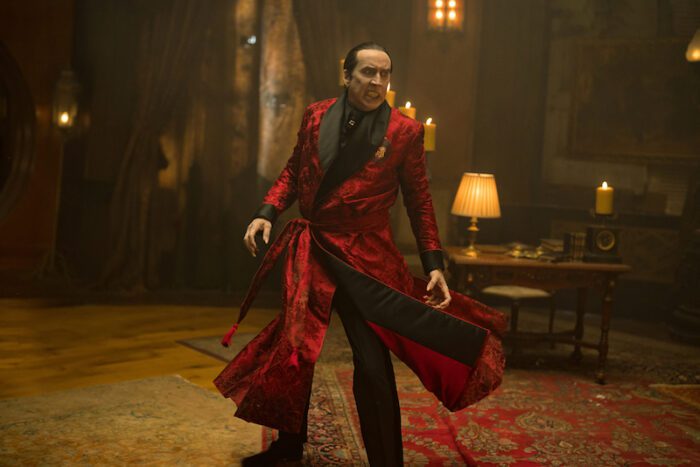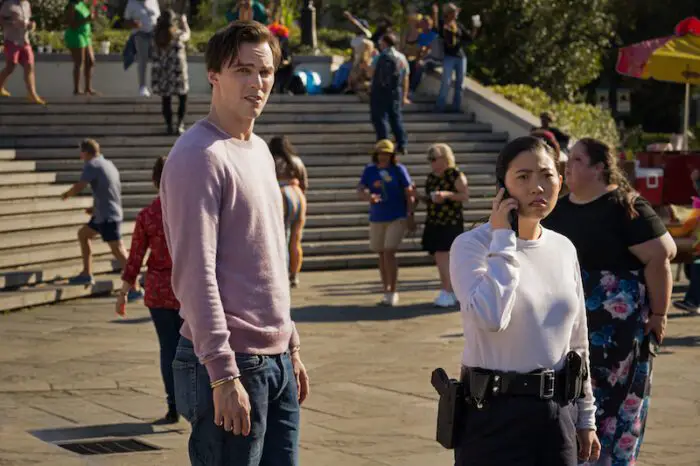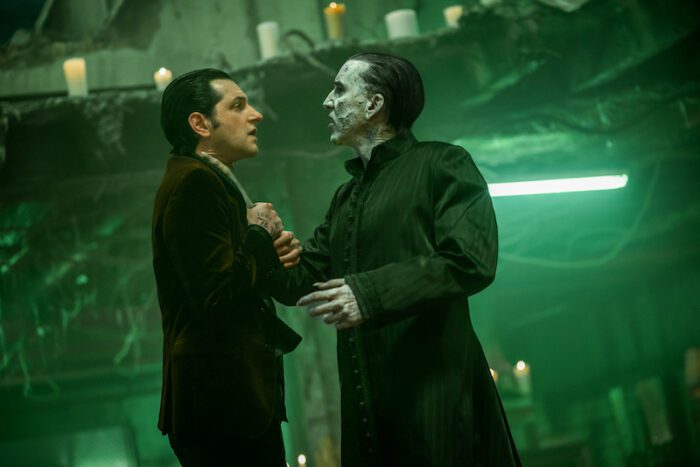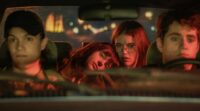When I heard several years back that Nicolas Cage was going to be portraying Dracula in Renfield, it sounded like some kind of destiny coming to fruition. After seeing his performance in the excellent Vampire’s Kiss, I was all but certain his return to the world of vampires was going to be splendid. Once the trailer revealed a bombastic horror-comedy, I was strapped in before the word “go”. Now that it’s here, I can’t at all say I’m disappointed. As it opened with cheeky narration from the titular Renfield (an adorable Nicholas Hoult), I felt relaxed in understanding I was in for an easygoing river-ride of a movie.
That isn’t to suggest Renfield has nothing to say, though it is its message that causes it to skid. Its abuse metaphor isn’t thinly veiled; it’s not veiled at all. I wouldn’t go as far as to call this aspect of the story bad, and it certainly doesn’t strain itself toward preachy, but it can sometimes read as a mite “textbook”—something you’d see in a college PSA about avoiding toxic relationships. That lack of a veil makes itself most obvious in the more dialog-heavy ruminations on Renfield as a character, but again, it’s not bad, merely ho-hum. Even so, the metaphor isn’t handled poorly. For all its on-the-nose-ness, it’s reasonably accurate in how it depicts codependency and the relationship between the abuser and the abused. I can fault the film for only some of its delivery, not all of it.

Otherwise, if you want a bloody romp, Renfield is your film. I’ve been a gore-hound for close to a decade and was not disappointed by Renfield’s carnage. If you’re looking for realism, however, go somewhere else. Renfield’s pools of blood look like some delectable tomato soup, which is great if you’re like me and enjoy some toon-like aesthetics intertwined with your live action. Renfield’s superhuman powers (attained by eating bugs [and not even special bugs; any bug lying around]) enable him to dismember and obliterate in a fashion only possible through the eyes of a camera.
The film’s most key downside unfortunately slithers into these bloodbaths, though: the action. I don’t know what the deal is, but a lot of people in Hollywood just don’t seem to have any idea how to shoot action sequences. A chunk of Renfield’s gory battles get swept up in a flurry of motion blur, making it difficult to comprehend what should be epic fight scenes. After being spoiled by works like RRR, Nobody, and Everything Everywhere All at Once, I have trouble getting past action sequences that feel like a feather duster being shaken in my face.
Thankfully, the rest of the visuals are quite stellar. I’m a sucker for ghostly turquoise, and Renfield is drowning in it. The sets are gorgeous and alive, allowing the even more lively characters to pop. For all its color, the grand prize goes to its exquisite black-and-white shot-for-shot remake of the original Dracula’s most famous moments between Renfield and Dracula. Seeing Hoult and Cage embody those timeless shots was a treat.
Renfield is also elevated by its music, which can at times seem a little wrought with popular songs, but not in a way where it feels like the songs are only included because they are popular. Some selections are rather cutesy, like Lizzo’s “2 B Loved (Am I Ready)” chronicling Renfield’s journey towards self-love. Others are only a hair more obscure, YUNGBLUD’s “superdeadfriends” providing a great track for an action sequence. The cake, however, goes to a brief use of My Chemical Romance’s “Na Na Na (Na Na Na Na Na Na Na Na Na)”, a band which I can’t recall ever hearing in a movie theater before now. I confess, the scene featuring the song could have done the magnificent track more justice, but the fact that it’s there at all was a pleasant surprise. Otherwise, the orchestral score provided by Marco Beltrami provides some brilliant ambiance and tunes that I actively revisit.

A chunk of the story winds up belonging to Rebecca, portrayed by Awkwafina. She is a policewoman trying to do the right thing in a broken system who also struggles with her father’s murder at the hands of the city’s leading crime family. Hollywood seems to be obsessed with the “one good cop” narrative as of late, something I have zero appreciation for. I am also not the biggest fan of the brunt of Awkwafina’s work, though I’m glad to report I didn’t mind her all that much here, nor did the “good cop” storyline feel too pandering. It makes up for itself a touch by maintaining the fact that the police system is irreparably broken and not suggesting that one good apple can fix a rotten tree, but the film would have remained interesting if it had not been included at all.
Renfield maintains its easygoing nature by having the story be sensibly bare bones. The characters are uncomplicated and even flat, but this works to Renfield’s advantage. Again, the sets are stupendous, and simplistic characters allow for those elements to shine, and results in the film not feeling overstuffed. Coming off films like A Thousand and One and Puss in Boots: The Last Wish—wonderful films, make no mistake—my brain can sometimes feel clogged by those dynamic characters who pose a lot of questions and offer much to consider. I have to admit, it is nice to have films like Renfield, where what you see is what you get, especially when what you get are lovable characters embodied by great actors.
Nicolas Cage makes for a very entertaining Dracula, not at all missing influence from what made his previously mentioned vampire flick so great. He’s out there, passionate, even sexy, and makes that costume feel lived in. He’s got Nicholas Hoult’s tall and sweet Renfield to contrast with, a meek man who craves normalcy versus a malicious agent of chaos. I would also be remiss not to mention Ben Schwartz’s nepo-mob-boss Teddy, an equally evil but considerably more weaselly and pathetic villain.

Renfield makes up for its shortcomings by being unabashedly silly when it must be and sincere when it wants to be. Its lack of subtlety may be off-putting at moments, but those moments are quickly drowned in red paint and screams. Director Chris McKay’s previous work on blessings like The LEGO Batman Movie most definitely influence the ultimate feeling of Renfield, which is probably the best thing about it. For Ryan Ridley’s first feature-length script, it has a strength to it I never would have pegged for that of a first timer. If he and McKay team up again, I’ll be paying attention.



